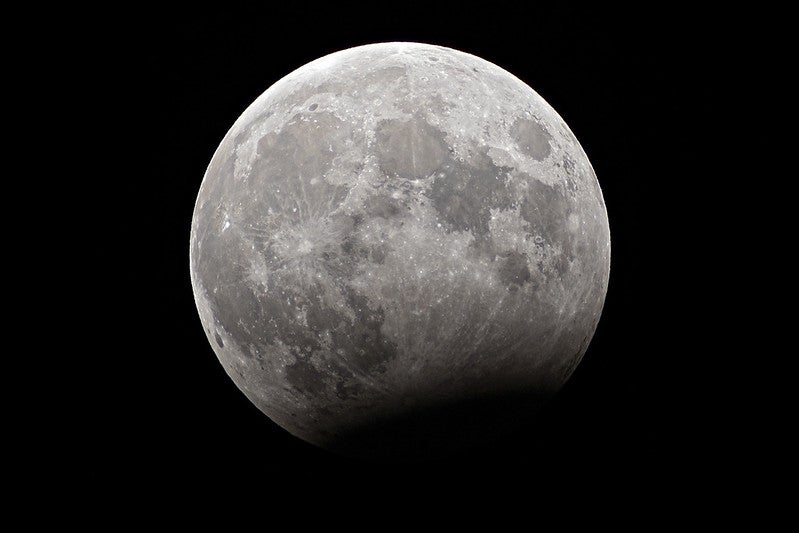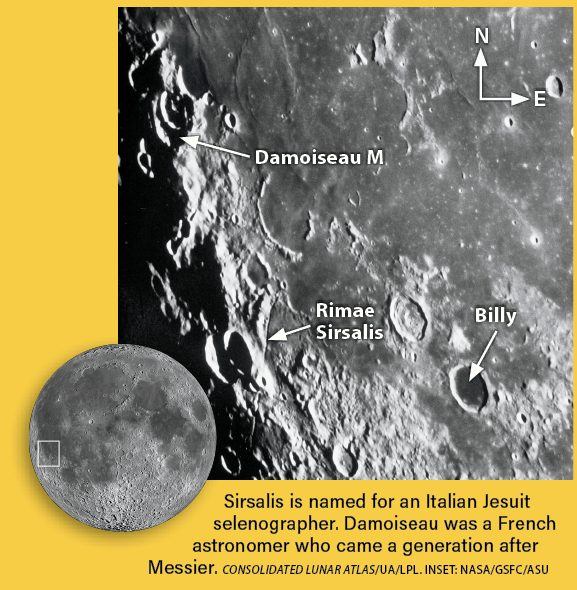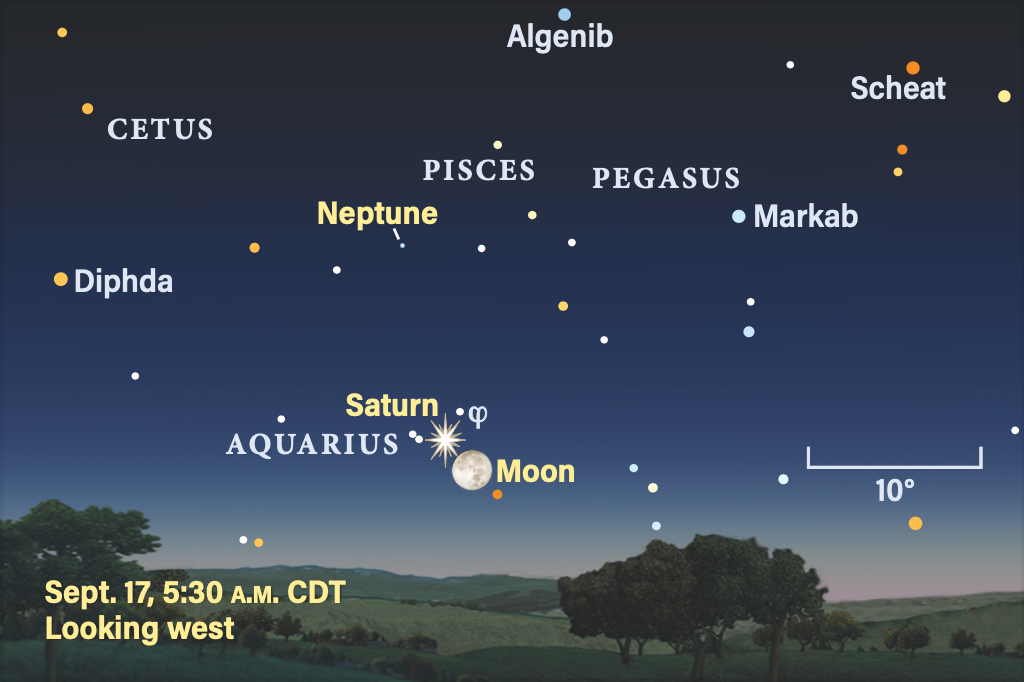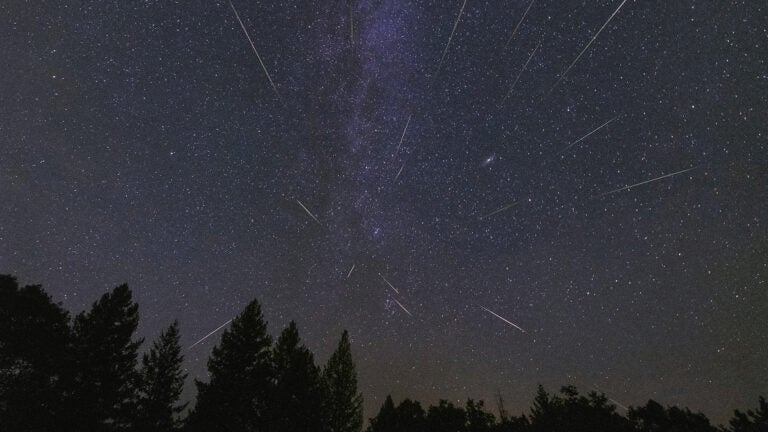
Friday, September 13
This Friday the 13th, let’s get ready for the upcoming spooky season by hunting a ghost — specifically, Mirach’s Ghost.
Mirach is cataloged as Beta (β) Andromedae, whose magnitude 2.1 glow matches that of the Princess’ alpha star, Alpheratz. It is located in the southern portion of the constellation, near its border with Pisces and Triangulum.
Through a telescope, Mirach appears noticeably orange, thanks to its relatively cool temperature — particularly compared to Alpheratz, which glows a hot blue-white. But when you look at Mirach through your telescope, you may notice a strange, ghostly object less than 7′ northwest of the star.
This is not an internal reflection — it’s a 10th-magnitude elliptical galaxy some 8,000 light-years away (far beyond Mirach, which sits just 200 light-years from Earth). Cataloged as NGC 404, it appears roughly 4’ in diameter from that distance, lying just beyond the boundary of our Local Group of galaxies. Like Mirach, the Ghost appears an orangey-red color as well, in this case because it is filled with similarly colored aging, cool stars.
Sunrise: 6:39 A.M.
Sunset: 7:11 P.M.
Moonrise: 4:53 P.M.
Moonset: 12:51 A.M.
Moon Phase: Waxing gibbous (75%)
*Times for sunrise, sunset, moonrise, and moonset are given in local time from 40° N 90° W. The Moon’s illumination is given at 12 P.M. local time from the same location.
Saturday, September 14
Tonight is International Observe the Moon Night, with celebrations across the globe highlighting Earth’s natural satellite. You can visit NASA’s page for the event to find a gathering near you, or simply step outside on your own this evening to enjoy a look at our waxing gibbous Moon, now just a few days from Full — and an upcoming lunar occultation and eclipse, so stay tuned for more details later this week.
Of course, Earth is far from the only planet with a natural satellite, and overnight tonight, one of Jupiter’s four large moons (also known as the Galilean moons) is transiting in front of its disk. You can find Jupiter in the constellation Taurus; the planet appears above the eastern horizon beginning around 11 P.M. local daylight time, to the lower left of the Bull’s bright red eye, Aldebaran. At magnitude –2.3, the planet far outshines the 1st-magnitude red giant.
Less than 15 minutes after midnight in the Midwest (1 A.M. EDT on the 15th), Io’s shadow appears on the planet’s southeastern limb. Io itself is about 20” behind it, farther east. Both shadow and moon are moving westward, with Io crossing onto the disk around 2:30 A.M. EDT (again on the 15th, but late on the 14th for those on the West Coast). The shadow continues across, leaving the disk around 3:20 A.M. EDT, with Io following at 3:41 A.M. EDT.
Also visible at this time are Europa farther to Jupiter’s east, as well as Ganymede and Callisto to the planet’s west, with the former sitting closer to the gas giant than the latter.
Sunrise: 6:40 A.M.
Sunset: 7:09 P.M.
Moonrise: 5:34 P.M.
Moonset: 2:03 A.M.
Moon Phase: Waxing gibbous (84%)

Sunday, September 15
Let’s turn back to the Moon tonight to focus on an area near its western limb as daylight makes its way across the surface. That daylight has now reached the southwestern edge of Oceanus Procellarum, the Ocean of Storms, one of the largest of the Moon’s dark maria.
Along that southwestern rim, look with a telescope for a smooth, round, dark-floored crater — that’s Billy. Its floor is composed of basaltic lava, which is what makes it so dark. To Billy’s northwest is a sharp, straight valley called Rimae Sirsalis, which appears to cut directly through the terrain as it shoots away from Oceanus Procellarum’s rim. The rille stretches for some 205 miles (330 kilometers). Even farther northwest is the double crater Damoiseau M.
This entire region is lit with long shadows, offering excellent contrast this evening. By tomorrow night, that will have changed, as the Sun moves overhead in the lunar sky and the shadows shorten, making it harder to closely examine the rugged terrain.
Sunrise: 6:41 A.M.
Sunset: 7:08 P.M.
Moonrise: 6:07 P.M.
Moonset: 3:20 A.M.
Moon Phase: Waxing gibbous (92%)
Monday, September 16
Rising higher in the northeast during the early hours of the morning, the constellation Lynx holds our target today. We’re looking for 10 Ursae Majoris — but don’t let the name fool you, because this star sits squarely within the boundaries of the Lynx (at least, these days).
Also cataloged as HR 3579 Lyncis, this 4th-magnitude star sits about 8.5° northwest of Lynx’s 3rd-magnitude alpha star. Alternatively, you can drop 5.5° due south of 4th-magnitude Kappa (κ) Uma to find it as well.
10 Uma is a double star with components that shine at 4th and 6th magnitude. They are both slightly more massive than the Sun and orbit each other every 22 years, appearing just ½” apart on the sky. That’s too close to split visually, but they can be tracked by studying the light from the seemingly singular star for shifts toward the red or blue end of the spectrum as the components orbit, called Doppler shifts.
If you’re looking for a binary pair you can split, slide your gaze north into Ursa Major proper, to the binary system Struve 1321, some 3° west of Theta (θ) Uma. This system contains two red dwarf stars, both 8th magnitude, which can be easily split using an 8-inch scope with a magnification of 100x, or higher magnification on a smaller scope. Both stars should appear an orangey-yellow color.
Sunrise: 6:42 A.M.
Sunset: 7:06 P.M.
Moonrise: 6:36 P.M.
Moonset: 4:39 A.M.
Moon Phase: Waxing gibbous (97%)

Tuesday, September 17
Today the Moon truly takes center stage, beginning early in the morning when the nearly Full Moon occults (passes in front of) the planet Saturn in Aquarius for observers in the western U.S. (including Hawaii) and Canada.
The event begins around 5 A.M. MDT, when the Moon and Saturn are just 10° high in the west in the Mountain time zone and 10° higher for those on the West Coast (and it’s an hour earlier, 4 A.M. PDT). Zoom in on Saturn with a telescope to watch the planet slowly slip behind the leading edge of the Moon over the course of roughly half a minute. Note that because the Moon is so bright, the planet and particularly its rings will appear quite faint. The International Occultation Timing Association’s website lists the timing from various cities, as the moment Saturn will disappear is heavily dependent on your location.
Those in the eastern half of the U.S. and Canada won’t see the occultation, but you can still watch the Moon closing in on Saturn as the pair sets in the west shortly before sunrise. There, the Moon passes 0.3° due north of Saturn at 6 A.M. EDT.
But the Moon isn’t done dazzling us yet. Full Moon occurs at 10:34 P.M. EDT, bringing us the September Corn Moon. But this Full Moon has so much more in store: It’s also the Harvest Moon, the name given to the Full Moon that occurs closest to the autumnal equinox (which is next week, on the 22nd). Plus, it’s a Super Moon, the name for a Full Moon that occurs around the same time as when our satellite reaches the closest point to Earth in its slightly elliptical orbit — a position known as perigee, which the Moon will hit tomorrow morning.
And finally, this Full Moon also precedes the upcoming annular solar eclipse October 2, bringing us a partial lunar eclipse as the celestial geometry gets lined up.
The eclipse begins at 8:41 P.M. EDT, which is shortly after the Moon rises for those in the Midwest. As first umbral contact approaches at 10:12 P.M. EDT, look at our satellite’s northern limb to see whether you notice it starting to turn a bit duskier as the eclipse progresses. At maximum eclipse (occurring at 10:45 P.M. EDT), just 8 percent of the Moon will be covered, but it will last for just over an hour. The eclipse then continues in reverse, with the northern limb of the Moon growing slowly brighter until the event ends at 12:47 A.M. EDT (on the 18th for those in the Eastern time zone only).
Sunrise: 6:43 A.M.
Sunset: 7:04 P.M.
Moonrise: 7:03 P.M.
Moonset: 5:58 A.M.
Moon Phase: Full
Wednesday, September 18
The Full Super Moon passes 0.7° north of Neptune at 4 A.M. EDT. If you’re still up after watching the eclipse, look for the pair as the region sets in the west as sunset approaches. Despite the Moon’s bright light, you might still be able to spot the stars of Pisces’ Circlet asterism, with the Moon standing some 5° to the left of Lambda (λ) Piscium, the southeasternmost star in the group.
Neptune will require a telescope to spot, also 5° from Lambda, to that star’s southeast. If you can, wait as long as possible for the Moon to pull farther away from the planet to avoid losing its faint, tiny disk among the glare. Distant Neptune glows at magnitude 7.7 and its disk stretches just 2” across; the ice giant will reach opposition in just two days’ time, so we’ll certainly return to it after the Moon has moved away just a bit and we can catch the blue-hued world at its best.
Still fully illuminated, the Moon reaches perigee, the closest point to Earth in its orbit, at 9:22 A.M. EDT, when it stands some 227,007 miles (365,332 km) away. This month’s Super Moon is the second of four such Super Moons this year, starting with the August Full Moon last month and ending with November’s.
Sunrise: 6:44 A.M.
Sunset: 7:03 P.M.
Moonrise: 7:28 P.M.
Moonset: 7:16 A.M.
Moon Phase: Waning gibbous (99%)
Thursday, September 19
Mercury reached a beautiful apparition earlier this month; now it is quickly “falling” out of sight, its distance from the Sun shrinking day by day as it heads for superior conjunction at the end of September.
Although it has been brightening — the planet now shines at magnitude –1.3 — Mercury is also rising later each morning. Today it reaches an altitude of just 3° above the horizon half an hour before sunrise, meaning observers should take care to set an alarm for several minutes before sunrise from their location, which may differ from the times given below.
You’ll likely need binoculars to spot it at all in the growing twilight. Through a telescope, the innermost planet’s disk spans 5″ and is nearly fully illuminated, with some 93 percent of its surface in sunlight.
As twilight grows, see how long you can follow a few of the other bright points of light in the sky: Blazing Jupiter in Taurus now acts as a morning star high in the south, while the bright stars Sirius in Canis Major and Procyon in Canis Minor may also remain visible, hanging below the planet in the southeast.
Sunrise: 6:45 A.M.
Sunset: 7:01 P.M.
Moonrise: 7:55 P.M.
Moonset: 8:34 A.M.
Moon Phase: Waning gibbous (96%)
Friday, September 20
The distant planet Neptune reaches opposition tonight at 8 P.M. EDT. Located in Pisces, you’ll find it hanging below magnitude 4.5 Lambda Psc as the constellation rises in the east this evening. The Moon has now moved to Aries; our satellite is still bright but there’s a short dark window after sunset to look for Neptune in a moonless sky.
An hour after sunset, Neptune is 10° high and lies 5° southeast of Lambda Psc. Now some 2.7 billion miles (4.3 billion km) from Earth, it glows at magnitude 7.7 and requires binoculars or a telescope to pick up. The planet’s disk will appear as a round, “flat” star among the background pinpricks of light, spanning just 2” across. You may notice the disk’s distinctive bluish hue.
Don’t mistake nearby Saturn for Neptune — the latter is in Pisces and not visible to the naked eye, while the former, in Aquarius, glows at magnitude 0.6 and is visible without optical aid.
Sunrise: 6:46 A.M.
Sunset: 6:59 P.M.
Moonrise: 8:24 P.M.
Moonset: 9:53 A.M.
Moon Phase: Waning gibbous (90%)

Sky This Week is brought to you in part by Celestron.









